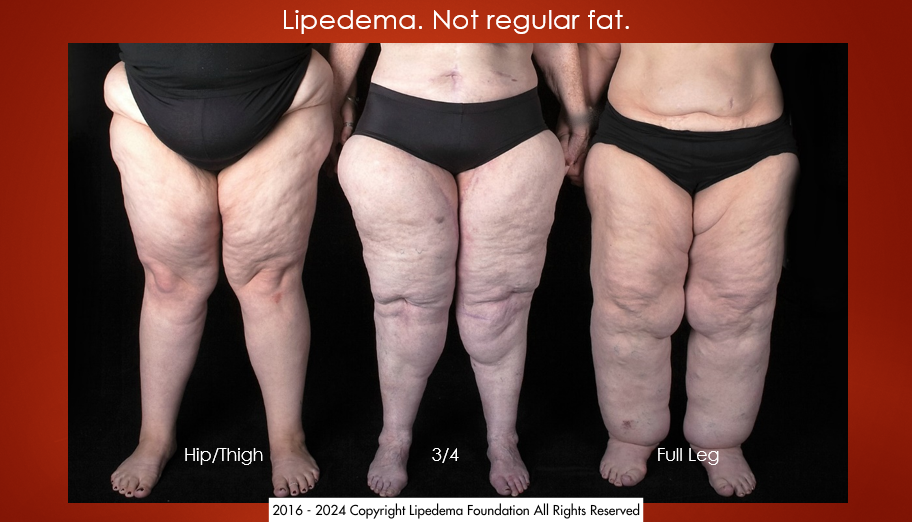Image sourced from the internet
Lymphedema/Lipedema/Complete Decongestive Therapy
Lymphedema is a swelling of one or more body parts. It often happens in the legs and arms but it can also happen to the neck, face or genitals. The condition of lymphedema is a result of abnormal accumulation of protein-rich edematous fluid in the affected area. This condition affects millions of people worldwide and can be primary lymphedema: meaning the cause is unknown/person was born with it, or secondary lymphedema, meaning the cause leading to the lymphedema is known.
Several conditions classified as a type of lymphedema respond well to manual lymphatic drainage and decongestive therapy. Complete Decongestive Therapy is a multi-phase approach that treats various forms of lymphedema, lipedema, venous insufficiencies, and edema. Some conditions that can benefit from complete decongestive therapy include:
Post cancer treatment edema
venous-related edema (chronic venous insufficiency, venous edema)
Post-injury edema
Edema due to hereditary conditions
congenital lymphatic malformations
chronic edema from kidney disease or heart disease
lipedema
lymphedema-distichiasis syndrome
radiation-induced lymphedema
obesity-informed lymphedema
Complete Decongestive Therapy can help a wide range of conditions and it can help many regain their quality of life. When you come into see us, we work with you to create a personalized treatment plan that works for you.
Lymphedema ranges from Stage 0 through Stage III.
Image sourced from the internet
Stage 0 Lymphedema: this is the latency stage and can involve various sensation changes, stasis leading to discomfort, heaviness or achiness. Symptoms can return to normal after activity or triggers are controlled but often return when the area is taxed. This could happen in one or more areas. We encourage those experiencing Stage 0 lymphedema to seek treatment right away to avoid progression.
Stage I Lymphedema: lymphedema starts to become more apparent at this stage. Swelling is present in the affected area. Swelling usually responds to elevation or light compression however, lymphedema at this stage typically progresses to stage II in weeks or months because the lymphatic vessels are laboring to maintain capacity. Early intervention at this stage helps counteract lymph accumulation and reduces the progression of lymphedema if there are no further complications or injuries to the lymph vessels.
Stage II Lymphedema: the continued imbalance between the lymphatic load and the lymphatic transport capacity has worsened and while swelling my fluctuate, it is persistent. There could also be lymphostatic fibrosis (connective tissue (collagen) deposition and other inflammatory elements). Stage II lymphedema is the most common form of lymphedema due to inadequate early identification and or delayed or inappropriate intervention.
Stage III Lymphedema: when lymphedema is neglected, it often progresses to stage III. There is usually extreme dermal hardening, distortions, connective tissue proliferation, further damage/impairment to the superficial lymphatic structures, infections risks, and other issues that continue to exacerbate damage to the lymphatic structures and worsen the lymphedema. Lymphedema at this stage requires more time in Phase I CDT.
MORE ABOUT COMPLETE DECONGESTIVE THERAPY
Complete Decongestive Therapy is a multi-modal, multi-phase approach consisting of intensive in-clinic treatment followed by ongoing self management at home and sometimes in conjunction with other treatments/therapies that further quality of life and relief from the edematous conditions.
In Phase I of CDT, we’ll conduct an initial appointment to assess your condition and conduct some tests. We’ll also discuss the treatment plan with you based on your presenting symptoms. The intensive phase can require visits for 3 or more weeks, depending on the severity of your condition, and as many as 3 times a week up to 7 days a week during the first week of treatment. Phase I therapies include manual lymphatic drainage, skincare, wound care (as needed), compression bandaging and exercise.
Manual lymphatic drainage: this therapy is a sequence of specific techniques that redirect fluid from congested and swollen areas to functioning lymphatic regions in the body.
Wound care: this therapy aids quicker closure of wounds, sores and promotes healing.
Compression bandaging/garments: this therapy utilizes specific multi-layered bandaging, padding and garments to promote the flow of fluid in swollen areas.
Skincare: we teach you tips to reduce the risk of infections, improve skin health, nail care and health and reduce sores/wounds.
Exercise: we take you through some range of motion exercises, stretches and aerobics exercises that help strengthen the lymphatic system and contribute to volume loss.
Phase II of CDT is maintenance of the progress made during the in-clinic phase. Maintenance can include getting fit for compression garments, self-bandaging, exercise plan, diet plan, skincare, nail care, self lymphatic drainage techniques and daytime/night time donning and doffing procedures that aid continued recovery from lymphedema/lipedema. We offer additional services in our phase II that are technology driven and we discuss that with you as pertaining to your particular needs. We also offer maintenance lymphatic drainage therapy, continued fibrosis reduction, circulatory system support, and fat reduction for those whose conditions necessitate that type of care.
Lymphedema and lipedema are chronic conditions. As a result, it can be sometimes necessary to return to Phase I again when conditions worsen. Continued care at home and intermittent clinical visits help to manage the condition and reduce Phase I intensive care needs.
LIPEDEMA (FLUID IN FAT)
Lipedema is a disorder of the subcutaneous loose connective tissue. Connective tissues comprise adipose (fat) cells, fascia, collagen and elastin fibers, extracellular matrix, immune cells, mast cells, lymphocytes, fibroblasts, and glycosaminoglycans (GAGs). Loose connective tissue (LCT) contain copious amount of water, proteins, electrolytes, nutrients, cell waste material and GAGs bound gel. Due to the presentation of lipedema, it is queried that lipedema is bound to GAGs in the extracellular matrix. This is because the fluid that is GAG- bound does not freely flow as lymph fluid does and do not move outside of the fibril matrix. The fat cells in lipedema can be painful. While lipedema is also treated with CDT, the two conditions are not the same. Lipedema is symmetrical enlargement of the limbs, mainly of subcutaneous fat tissue but it can also have lymphedema components. Lipedema fat is difficult to lose through dieting, exercise or bariatric surgery. Lipedema mostly impact women and is often misunderstood as obesity. In the early stages, lipedema spares the feet, hands and tends to concentrate increased tissue on the lower abdomen, hips, buttocks, thighs, and legs. In the later stages, it can extend further up the abdomen, into the upper extremities and become fibrotic.
Additional symptoms of lipedema include joint hypermobility, valgus knee, ankle pronation, muscle weakness, hyperlordotic lumbar spine, easy bruising, tenderness and pain in the affected areas, leg swelling despite elevation, spider and varicose veins, hyperthyroidism in up to 36% of affected individuals, increased risk of hypovitaminosis D with increased weight, abdominal pain, constipation, diarrhea, bloating, shortness of breath, sleep apnea and other sleep issues.
image sourced from Lipedema Foundation
Lipedema causes body disproportion and the enlarged fat on the thighs, inner knees and calves can limit mobility. The build up can be around the buttocks, hips, pelvis, buttocks to knees, buttocks to ankles and or around the inner sides of the knees. In the arms, the affected tissue can be at the upper arms, lower arms or throughout the entire arms. Lipedema can affect other areas, not just the legs and arms it is described by stages and types.
Stage 1 lipedema: the skin is smooth however there are increased subcutaneous fat tissue present. The fat present can be small nodules described as rice-like, styrofoam balls in a plastic bag, pearl-sized or pebble-like and can be felt under the surface of the skin.
Stage 2 lipedema: fat may be thickened, hardened, fibrotic. There is uneven skin surface with dimpling, indentations and/or wavy orange peel look or mattress pattern look. Large nodules, ranging from walnuts size to apple size may be felt under the surface of the skin.
Stage 3 lipedema: there are extrusions of fat that are forming lobules (folds of fat), even larger masses or overhangs of fat causing deformations that can be observed, especially on the thighs and around the knees. It is not uncommon to see thickening fat nodules and fibrotic tissue.
TYPES OF LIPEDEMA
Lipedema typology helps to explain the location of the fat. Types of lipedema were originally described in women to better identify the presentation of the condition.
Type I: accumulation affects the lower abdomen, over the hips and buttocks.
Type II: accumulation affects buttocks to the knees with folds of fat around the inner knee.
Type III: accumulation affects the lower abdomen, buttocks to the ankles.
Type IV: accumulation affects the arms.
Type V: accumulation affects the lower legs.
LIPOLYMPHEDEMA
When there is protein rich accumulation of lymph causing swelling and lipedema, the condition of lipolymphedema is queried. In those experiencing lipedema, lymphedema can also be equally present.
ADDITIONAL THERAPEUTIC APPROACHES FOR LIPEDEMA
In addition to CDT, we address the network of fibers called microvacuoles within the connective tissues network to aid better function of the connective tissues, reduce fibrosis, improve lymphatic flow, heaviness and lymphedema. We offer adjunctive therapies that support reduction of lipedema nodules, texture, volume, as well as the management of inflammation and pain.
Sources:
Lipedema Foundation
Lipedema.com
Fat Disorders Resource Society
National Lymphedema Network
Lymphatic Education and Research Network



